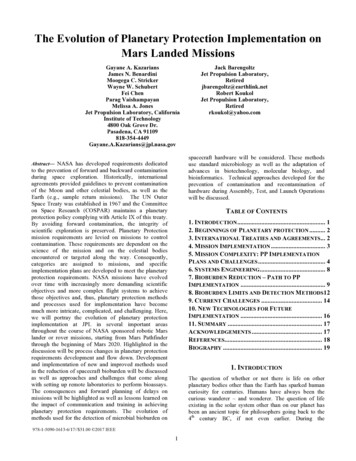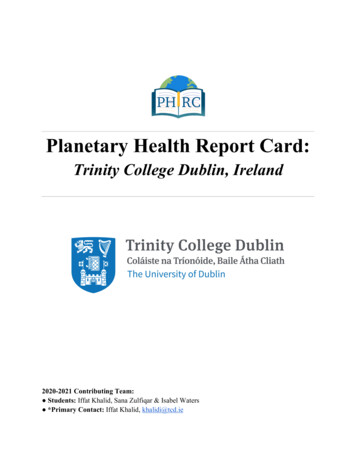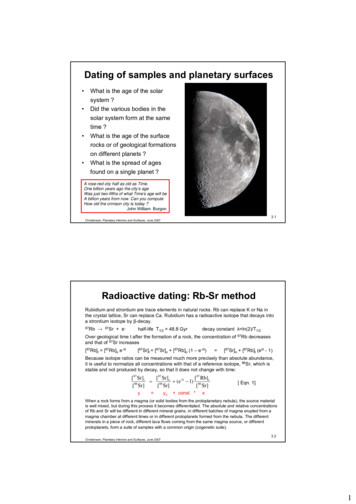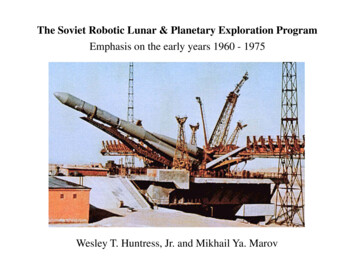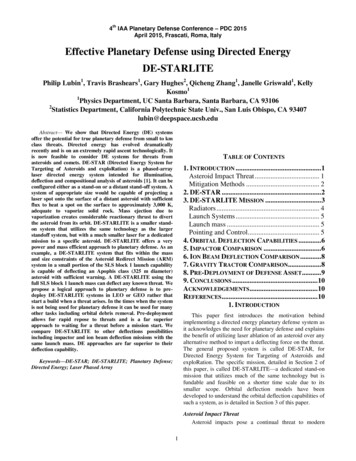
Transcription
th4 IAA Planetary Defense Conference – PDC 2015April 2015, Frascati, Roma, ItalyEffective Planetary Defense using Directed EnergyDE-STARLITEPhilip Lubin1, Travis Brashears1, Gary Hughes2, Qicheng Zhang1, Janelle Griswald1, KellyKosmo11Physics Department, UC Santa Barbara, Santa Barbara, CA 931062Statistics Department, California Polytechnic State Univ., San Luis Obispo, CA 93407lubin@deepspace.ucsb.eduAbstract— We show that Directed Energy (DE) systemsoffer the potential for true planetary defense from small to kmclass threats. Directed energy has evolved dramaticallyrecently and is on an extremely rapid ascent technologically. Itis now feasible to consider DE systems for threats fromasteroids and comets. DE-STAR (Directed Energy System forTargeting of Asteroids and exploRation) is a phased-arraylaser directed energy system intended for illumination,deflection and compositional analysis of asteroids [1]. It can beconfigured either as a stand-on or a distant stand-off system. Asystem of appropriate size would be capable of projecting alaser spot onto the surface of a distant asteroid with sufficientflux to heat a spot on the surface to approximately 3,000 K,adequate to vaporize solid rock. Mass ejection due tovaporization creates considerable reactionary thrust to divertthe asteroid from its orbit. DE-STARLITE is a smaller standon system that utilizes the same technology as the largerstandoff system, but with a much smaller laser for a dedicatedmission to a specific asteroid. DE-STARLITE offers a verypower and mass efficient approach to planetary defense. As anexample, a DE-STARLITE system that fits within the massand size constraints of the Asteroid Redirect Mission (ARM)system in a small portion of the SLS block 1 launch capabilityis capable of deflecting an Apophis class (325 m diameter)asteroid with sufficient warning. A DE-STARLITE using thefull SLS block 1 launch mass can deflect any known threat. Wepropose a logical approach to planetary defense is to predeploy DE-STARLITE systems in LEO or GEO rather thatstart a build when a threat arises. In the times when the systemis not being used for planetary defense it can be used for manyother tasks including orbital debris removal. Pre-deploymentallows for rapid repose to threats and is a far superiorapproach to waiting for a threat before a mission start. Wecompare DE-STARLITE to other deflections possibilitiesincluding impactor and ion beam deflection missions with thesame launch mass. DE approaches are far superior to theirdeflection capability.TABLE OF CONTENTS1. INTRODUCTION .1Asteroid Impact Threat . 1Mitigation Methods . 22. DE-STAR .23. DE-STARLITE MISSION . 3Radiators . 4Launch Systems . 5Launch mass . 5Pointing and Control . 54. ORBITAL DEFLECTION CAPABILITIES .65. IMPACTOR COMPARISON .66. ION BEAM DEFLECTION COMPARISON .87. GRAVITY TRACTOR COMPARISON.88. PRE-DEPLOYMENT OF DEFENSE ASSET .99. CONCLUSIONS .10ACKNOWLEDGEMENTS .10REFERENCES .101. INTRODUCTIONThis paper first introduces the motivation behindimplementing a directed energy planetary defense system asit acknowledges the need for planetary defense and explainsthe benefit of utilizing laser ablation of an asteroid over anyalternative method to impart a deflecting force on the threat.The general proposed system is called DE-STAR, forDirected Energy System for Targeting of Asteroids andexploRation. The specific mission, detailed in Section 2 ofthis paper, is called DE-STARLITE—a dedicated stand-onmission that utilizes much of the same technology but isfundable and feasible on a shorter time scale due to itssmaller scope. Orbital deflection models have beendeveloped to understand the orbital deflection capabilities ofsuch a system, as is detailed in Section 3 of this paper.Keywords—DE-STAR; DE-STARLITE; Planetary Defense;Directed Energy; Laser Phased ArrayAsteroid Impact ThreatAsteroid impacts pose a continual threat to modern1
civilization. On 15 February 2013, an asteroid penetratedthe atmosphere over Chelyabinsk, Russia entering at anangle of approximately 18 , and releasing energy equivalentto 570 150 kt TNT [2]. For comparison, the nuclearweapon that was detonated approximately 509 m above theground in Hiroshima, Japan yielded approximately 12.5 ktTNT [3]. The main airburst over Chelyabinsk occurred at anapproximate altitude of 30 km and created a shock wavestrong enough to shatter windows out to a distance of 120km from the meteorite’s track, injuring over 1,200 people inChelyabinsk city and hundreds more in nearby towns andrural areas [2]. Had the asteroid approached from a higherangle, more serious damage would be anticipated fromhigher concentration of the impact energy on the ground.Sixteen hours after the meteorite struck nearChelyabinsk, the 45 m diameter asteroid 2012 DA14approached to within 27,743 km of Earth's surface—insidethe orbit of geosynchronous satellites. If DA14 were tostrike Earth, it would deliver approximately 7.2 Mt TNT [4].Although the Chelyabinsk meteorite and DA14 arrived at ornear Earth on the same day, the two objects were not linkedto each other, coming from completely unrelated orbits.That two such seemingly improbable events could occurwithin hours of each other serves as a stark reminder thathumanity is continually at risk of asteroid impact.Asteroids at least the size of DA14 ( 50 m diam.) areexpected to strike Earth approximately every 650 years,while objects at least the size of the Chelyabinsk impactor( 20 m diam.) are expected to strike Earth approximatelyevery 100 years [4]. Larger objects also pose a severe threat,as the total kinetic energy associated with an impact of a100 m asteroid is equivalent to approximately 85 Mt TNT,and that of the well-known 325 m threat, Apophis, isapproximately 3.2 Gt TNT [4]. Thus, effective mitigationstrategies are imperative to ensure humanity’s continuityand future advancement.laser ablation method, as proposed for the DE-STARLITEmission [13].(5) Indirect orbit alteration, such as gravity tractors: Aspacecraft with sufficient mass would be positioned near theobject, and maintain a fixed station with respect to theobject using onboard propulsion. Gravitational attractionwould tug the object toward the spacecraft, and graduallymodify the object’s orbit [14], [15].(6) Expulsion of surface material, e.g. by robotic mining: Arobot on the surface of an asteroid would repeatedly ejectmaterial from the asteroid. The reaction force from ejectedmaterial affects the object’s trajectory [16].(7) Vaporization of surface material: Similar to roboticmining, vaporization on the surface of an object continuallyejects the vaporized material, creating a reactionary forcethat pushes the object into a new path. Vaporization can beaccomplished by solar concentrators [17] or by lasers [18]deployed on spacecraft stationed near the asteroid, the latterof which is proposed for the DE-STARLITE mission(Section 3). During laser ablation, the asteroid itselfbecomes the "propellant"; thus a very modest spacecraft candeflect an asteroid much larger than would be possible witha system of similar mission mass using alternativetechniques.2. DE-STARThe DE-STAR concept is envisioned as an orbitingsystem consisting of a modular array of phase-locked laserspowered by photovoltaics [1]. The multi-purpose system iscapable of planetary defense against asteroids that areprojected to collide with the Earth. Laser ablation of theasteroid imparts a deflecting force on the target in order tomitigate the risk of impact. The laser produces a spot on thetarget that heats the surface at the spot to a temperature greatenough to vaporize all known constituent materials—approximately 3,000 K. The vaporization consequentlycreates a reactionary force that diverts the asteroid. Recentadvances in photonics make a scientific discussion ofdirected energy planetary defense feasible whereas even 10years ago it was close to science fiction. High power lasersare capable of delivering sufficient energy density on atarget to melt and vaporize any known material. Lasermachining and welding are commonplace in industry, whereeven refractory metals are directly machined or joined withlasers. Scaling of laser technology has spurred developmentof directed energy systems that are capable of deliveringhigh energy density on distant targets. Recent developmentshave resulted in conversion of electrical to photonefficiencies of close to 50% with powers in excess of 1 kWper (handheld) unit. Additionally, and critical for thisprogram, such devices can be phased locked. This field israpidly changing and even more efficient devices withhigher power density will be available in the near future.This allows us to contemplate directed energy systems forlarge scale deployment. Inside the Earth's atmosphere,directed energy systems are hindered by atmosphericfluctuations of the coherent beam. A directed energy systemdeployed above the atmosphere could project a beamMitigation MethodsSeveral concepts for asteroid deflection have beendescribed, which can be broadly generalized into six distinctstrategies.(1) Kinetic impactors, with or without explosive charges:An expendable spacecraft is sent to intercept the threateningobject. Direct impact would modify the object’s orbitthrough momentum transfer. Enhanced momentum transfercan be accomplished using an explosive charge, such as anuclear weapon [5], [6], [7], [8].(2) Gradual orbit deflection by surface albedo alteration:The albedo of an object could be changed using paint [9],mirrors [10].(3) , sails [11], etc. As the albedo is altered, a change in theobject’s Yarkovsky thermal drag would gradually shift theobject’s orbit.(4) Direct motive force, such as by mounting a thrusterdirectly to the object: Thrusters could include chemicalpropellants, solar or nuclear powered electric drives, or ionengines [12]. Such methods, including ion beam deflection(IBD), require much greater mission mass than does the2
through space unfettered by atmospheric interference andthus allows us to design systems that are essentiallydiffraction limited as the interplanetary medium (IPM) isextremely tenuous and does not affect the laser beamsignificantly. The system consists of a large array of phaselocked modest power laser amplifiers. By controlling therelative phases of individual laser elements, the combinedbeam can be directed to a distant target. Lasers are poweredby solar photovoltaics of essentially the same area as thelaser array. By increasing the array size we can both reducethe spot size due to diffraction and increase the power. Thisdual effect allows us to vaporizing elements on the surfaceof asteroids at distances that are significant compared to thesolar system. By raising the flux (W/m2) on the targetasteroid to a sufficiently high level we can begin directevaporation of the asteroid at the spot. This has two basiceffects. Firstly, we directly begin to evaporate the asteroidand given sufficient time, a threatening asteroid could betotally vaporized before hitting the Earth. Secondly,evaporation at the spot causes a back reaction on theasteroid from the vaporization plume which acts as a rocketand thus the asteroid can be deflected. Since DE-STAR is aphased array consisting of a very large number of elementsit can simultaneously be used for multiple purposes and isintrinsically a multi-tasking system. Fig. 1 depicts anorbiting DE-STAR system simultaneously engaged in bothevaporating and deflecting a large asteroid as well aspowering and propelling a spacecraft. The system consistsof an array of phase-locked lasers. By controlling therelative phases of individual laser elements, the combinedbeam can be directed to a distant target. Lasers are poweredby a solar panel of effectively the same area as the laserarray. A DE-STAR of sufficient size would be capable ofvaporizing elements on the surface of asteroids. Givensufficient time, a threatening asteroid could be vaporized,deflected or disintegrated prior to impacting Earth. Theability to direct energy onto a distant target renders DESTAR capable of many functions. Asteroid interrogationmay be possible by viewing absorption lines as the heatedspot is viewed through the ejected vapor plume. Photonpressure can be used to accelerate (and decelerate)interplanetary spacecraft, among many other possibilities.As this is a modular system we classify each DE-STARby the log of its linear size, thus a DE-STAR 1 is 10 m, DESTAR 2 is 100 m, etc. A DE-STAR 4 system will produce areaction thrust comparable to the Shuttle SRB on theasteroid due to mass ejection and thus allow for orbitaldiversion of even larger asteroids, beyond several km indiameter, thus allowing for protection from every knownasteroid threat. Smaller systems are also extremely useful.For example, a DE-STAR 2 (100 m array) would be capableof diverting volatile-laden objects 100 m in diameter byinitiating engagement at 0.01-0.5 AU (AU AstronomicalUnit mean distance from Earth to Sun 1.5x10 11 m).Smaller objects could be diverted on shorter notice. Thephased array configuration is capable of creating multiplebeams, so a single DE-STAR of sufficient size could engageseveral threats simultaneously, such as a Shoemaker-Levy 9scenario on Earth. An orbiting DE-STAR would also becapable of a wide variety of other functions. Narrowbandwidth and precision beam control would aid narrowsearch and ephemeris refinement of objects identified withwide-field surveys. Propulsion of kinetic or nuclear tippedasteroid interceptors or other interplanetary spacecraft ispossible using the "photon rail gun" mode from directphoton pressure on a spacecraft, propelling (for example) awafer scale spacecraft to c/4 in 10 minutes to reach thenearest stars in about 15 years, a 100 kg craft to 1 AU in 3days or a 10,000 kg craft to 1 AU in 30 days. Vaporizationand de-orbiting of debris in Earth orbit could beaccomplished with a DE-STAR 1 or 2 system. DE-STAR 3and 4 arrays may allow standoff interrogation of asteroidcomposition by observing absorption lines in the blackbodyspectrum of a vaporizing surface spot. There are a numberof other applications as well, including downlink power viamm, microwave or laser—the so called Space PowerSystem mode. The system is a standoff planetary defensesystem that is always ready when needed and no dedicatedmission is needed for each threat as is the case with otherproposed mitigation methods.3. DE-STARLITE MISSIONWhile the larger DE-STAR system remains a long termgoal, DE-STARLITE is a more feasible and fundablemission as it is a smaller, stand-on version of the largerstandoff system. DE-STARLITE is designed to be sent on aspacecraft with a 1 m to 4.5 m diameter array, to arrivenearby a Near-Earth Asteroid (NEA) and deflect it from itspotentially hazardous trajectory. The laser array isessentially the same as for the DE-STAR program but vastlysmaller. A secondary approach with a lower risk potentialfallback is a close-packed focal plane array of fiber lasers[13]. DE-STARLITE is made possible with high-powersolar electric propulsion (SEP). PV panels will be stowedfor launch and will deploy upon reaching low-Earth orbit(LEO) to provide a required 100 kW electrical power fromtwo 15 m diameter ATK MegaFlex panels. Even largerpower is possible within the launch mass and shroud sizesavailable. The system will utilize ion engines (detailedFigure 1. Left: Concept diagram of an orbiting DE-STARengaged in multiple tasks including asteroid diversion,composition analysis and long range spacecraft power andpropulsion. Right: Visualization with relevant physicalphenomenon included at a flux of about 10 MW/m2. Plumedensity is exaggerated to show ejecta. Asteroid diameter isabout that of Apophis (325 m) relative to the laser beamdiameter (30 m). Target is at 1 AU.3
below) to propel the spacecraft from LEO to an NEA, asproposed in JPL’s ARM program [13]. The system aims tostay within the same mass and launch constraints as ARMand use much of the same propulsion technology. The laserefficiency determines the laser power obtained from the PVarrays; 35 kW of laser power would be produced at 35%efficiency, 50 kW at 50%, and 70 kW at 70%. The 35 kWestimate is based on the current efficiency (35%) of existingtechnology of the baseline Ytterbium laser amplifiers andthus provides for the worst case, while the 50 and 70 kWestimates are based on feasible technological improvementwithin the next 5-15 years. For example, 50% efficiencylooks readily achievable within less than 5 years. A passivecooling radiator with z-folded arrays will be used to rejectwaste heat and maintain the temperature at near 300 K.Conceptual drawings of the system and payload are shownin Fig. 2 and Fig 3.RadiatorsThermal radiators are critical to maintain the lasers andspacecraft at a reasonable temperature. Our baseline is tokeep the amplifiers near 300 K. The efficiency of theradiator can be determined by:(1)whereis the emittance of the surface, is the StefanBoltzmann constant, T is the temperature,is the heatrejected, A is the area, and F is the flux. The baselineradiator will be coated in AZ-93 white paint, which has ahigh emittance of 0.91 0.02 (or conservatively, 0.89) and alow alpha, as it only absorbs 14-16% of incident sunlight onthe spacecraft. The goal is to maintain a temperature of 300K, as both the laser and onboard control electronics areoperational at this temperature. At this temperature, theradiator can reject an idealized outward flux of 408 W/m2.When taking into account the incident radiation, using asolar constant of 1,362 W/m2 and a maximum 16%absorptance, the net flux of energy across the surface of theradiator is approximately 190 W/m2. The baseline is toprevent direct solar illumination of the radiator.The area of the radiator must be determined by thermalanalysis, and is dependent on the desired operatingtemperature, heating from the environment, interactionswith other surfaces of the spacecraft (e.g., solar arrays), andthe highest estimate (worst case) satellite waste heat. Thewaste heat in this case is dependent on the efficiency of thelaser amplifiers—35%, 50%, or 70%, as mentioned. Theworst-case estimate (35% efficiency) requires 65 kW to berejected as waste heat for a 100 kW electrical inputassuming virtually all the power goes to the laser (which isapproximately correct during laser firing).Figure 2. Artistic rendering of a deployed DE-STARLITEspacecraft deflecting an asteroid. The spacecraft is outfitted withtwo 15 m diameter MegaFlex PV Arrays, a z-folded radiatordeployed up and down, a laser array mounted on a gimbal at thefront, and ion engines at the back. From Kosmo et al. [13].rejected The PV panels are currently scalable to about 450 kWper pair and have a mass per unit power of about 7 kg/kW.The minimum flux on target requirement is set by thematerial properties. We have focused or work on the worstcase of high temperature materials that require spottemperature of 2,000-3,000 K for efficient mass ejection.This is discussed in detail in a series of papers our group haspublished. An example of a 3D simulation for a typicalrocky material is shown. Surface flux above 10 MW/m2 issufficient to efficiently ablate most materials of interest.AFnet(2)where Fnet is the net outward flux and is the heat rejected.Given these parameters, the maximum required area of theradiator is 341 m2 for a 35% efficient laser amplifier. For a50% efficient laser, a radiator area of 262.1 m2 is required;for a 70% efficient laser, a radiator area of 157.2 m2 isrequired.Figure 4. Left: Simulation showing one spot from the baselinephased array on the target at sufficient temperature to causeablation. Right: Multi-beam simulation depicting 19 beams onthe target from an optional choice of a close packed laser arrayinstead of a phased array.Figure 3. Conceptual design of the deployed spacecraft withtwo 15 m PV arrays that produce 50 kW each at the beginningof life for a total of 100 kW electrical, ion engines at the back,and the laser array pointed directly at the viewer. A 2 mdiameter laser phased array is shown with 19 elements, each ofwhich is 1-3 kW optical output. From Kosmo et al. [13].A passive cooling z-folded radiator consisting of twodeployable panels will be used in order to provide a4
sufficient surface area over which to emit the waste heatgenerated by the system. Each panel z-folds out into sixsegments, each of which further folds out into twoadditional segments, making 18 segments in total for eachpanel. The panels will rotate about their axes to maximizeefficiency by remaining perpendicular to the sun and byradiating out of both sides. Each segment will be 2.2 m by2.2 m, granting a total area of 348 m2 out of which todissipate heat. This will provide sufficient surface area toreject the maximum projected waste heat. If by the time ofproduction, significant increases in laser efficiency haveindeed been reached, the size of the panels can be altered soas to reduce the excess mass if less heat needs to bedissipated. Sun shades may also be employed to limit solarabsorption and thus allow for greater efficiency. The currentmass to power ratio for radiators is about 25 kg/kW for theARM system as a baseline example. Radiators are currentlythe largest mass driver for large systems. This is an area thatneeds additional work, though even with the existingradiator designs, MW-class systems are feasible withcurrent (or soon to exist) launchers. More laser amplifiersare easily added to allow for scaling to larger power levels.A 1 m to 4.5 m diameter is feasible; no additional deflectioncomes from the larger optic, just additional range from thetarget.Figure 5. Stowed view of DE-STARLITE.Table 1. Parameters of various launch vehicles inconsideration for DE-STARLITE.Atlas VSLSFalconDelta IVParameter551Block 1HeavyHeavyPayload Mass18,50070,00053,00028,790to LEO (kg)Cost per unit 13 k/kg 19 k/kg 1.9 k/kg 13 k/kgmass to LEOFairing5.48.45.25Diameter (m)StatusFlightExpected ExpectedFlightproven20172015provenLaunch SystemsThe launch systems in consideration are Atlas V 551,Space Launch System (SLS) Block 1, Falcon Heavy, orDelta IV Heavy. These are likewise the launch systems inconsideration for ARM, which calls for a payload ofcomparable parameters [13]. The DE-STARLITE spacecraftwill fit within the payload fairing of any of the proposedlaunch systems (Fig. 5). As is evident from data in Table 1,the SLS Block 1 has the highest capabilities though a futuredesign for the SLS Block 2 is projected to lift 130,000 kg toLEO. The Falcon Heavy has the smallest cost per unit mass,and has capabilities between that of the Atlas V and SLSBlock 1. While the Atlas V 551 and Delta IV Heavy havepreviously undergone successful missions, the SLS Block 1and Falcon Heavy are projected to be flight-proven withinthe timescale of the DE-STARLITE mission.As with ARM, it is possible to compensate for the lowercapabilities of the Atlas V by using the SEP system to spiralout of Earth’s orbit and escape from Earth using LunarGravity Assist (LGA); however, this process of spiraling outand using LGA will take an additional 1 to 1.5 years offlight. All of these factors must be taken into considerationto choose the most effective launch system for the DESTARLITE mission.Launch massIt is assumed in our analysis that a DE-STARLITEmission will use conventional launchers to get to LEO andthen use ion engines, of a similar type to what is on theARM mission to get from LEO to the target and then use thelaser to do the actual target deflection. The launch mass iscomputed using many of the same assumptions used for theARM mission but with the addition of the laser array andlarger PV and radiators. The launch mass required vs.electrical power produced by the solar PV is shown. Thelaser power will be about 50% of the electrical power withassumed 50% conversion efficiency. This is a slightlyoptimistic assumption but well within the near termroadmap for the baselined Yb laser amplifiers.Pointing and ControlThe laser pointing control system uses a servo feedbackbased upon a SWIR camera observation of the spot intensityto control the phasing of each laser sub element to maximizethe spot intensity. Phase control can also be used to move5
the spot as needed on the target. Gross pointing is performedby the gimbal and bulk spacecraft motion. Spacecraftattitude control uses small ion engines.for the full numerical simulation of the orbital deflectionalong with the nominal Δv and 3Δv simplifications. It isevident that the 3Δv approximation is indeed only anapproximation and in some cases fails badly.The numerical simulations were performed in a rotatingframe, where the thrust was pointed both along and againstthe velocity vector for comparison. Many dozens of orbitalsimulations were analyzed. Fig. 7 compares the laser-activetime to the miss distance for a given thrust acting on targetsof varying diameter. This focuses on the 325 m diameterasteroid case, as this is approximately the size of Apophis—a well-known possible threat. Computations have also beendone for 20 to 1,000 m asteroids under many missionscenarios. The same code is used to analyze IBD, gravitytractor and impactor (impulse) cases to which DESTARLITE are compared.4. ORBITAL DEFLECTION CAPABILITIESThis section describes how magnitude and duration ofapplied thrust influence miss distance. When an asteroid isexposed to the DE-STARLITE laser, the temperature (K)and flux (W/m2) on the target asteroid must approachsufficiently high levels in order for significant ablation tooccur, targeting a temperature on the order of 3,000 K and aflux of 107 W/m2. This causes direct evaporation of theasteroid at the spot of contact. Evaporation at the spotproduces a vaporization plume thrust (N) that can be used tochange the asteroid’s orbit and effectively deflect asteroidsfrom colliding with Earth. A miss distance of at least twoEarth radii (12,742 km) is required to eliminate the threat ofcollision. The orbital deflection depends on the duration,magnitude, and direction of the applied thrust.Figure 6. Miss distance vs. laser on time for orbitalsimulation with Δv and 3Δv approximations; nominal 2 Nthrust ( 30 kW laser, a modest case for a DE-STARLITEmission). More thrust is available with larger arrays.Figure 7. Estimated deflection time (laser on time) vs. targetdiameter and DE-STARLITE electrical power input fromPV assuming a 3Δv approximation often over estimates thedeflection (miss) distance. True mission planning requiresdetailed knowledge of the target orbit and the detailedinterdiction scenario. Note that 200 m diameter asteroids canbe deflected in 1 year using a MW class laser; largerasteroids require more time. A MW laser DE-STARLITEmission appears to be launchable with an SLS Block 1.Full Numerical Orbital Simulations vs AnalyticApproximations - A three-body simulation (accounting forthe gravitational effects of the Earth, the sun, and the targetasteroid) was performed in order to analyze how the appliedthrust and the laser-active time impact the miss distance. Inorder to determine the orbital deflection, x, of an asteroidthat is being acted on over a period of time, t, anapproximation that is commonly used in orbital mechanicswas used as a comparison. The detailed numericalsimulation is compared to the approximation of multiplyingby 3 the naive distance achieved by accelerating andcoasting a system that is not a bound gravitational system.Hence the orbital deflection is compared to: xapprox 3(0.5 a·tactive2 a·tactive·tcoast )(3)where a is the acceleration caused by the plume thrust, tactiveis the time the laser is active, and tcoast is the coast time(typically zero). The reason this is done is because thisapproximation is often used for preliminary mission design.Fig. 6 compares the 1Δv and 3Δv approximations. Asample of the results for the 325 m asteroid case is shown5. IMPACTOR COMPARISONReference [1] discusses the case of IBD vs. laser ablationdeflection. Here we discuss the case of using an impactor(ramming asteroid) vs. using a laser. As a common metricwe use the launch mass as a common element for bothcases–i.e., for the same launch mass, what can each systemdo?For a simplistic analysis the impactor delivers a largeimpulse or momentum transfer to deflect the target(integrated force - time in units of Ns). This momentumtransfer imparts a change in the speed ΔV of the asteroidequals Δp/M where M is the mass of the asteroid. Δp is theimpulse delivered at a time τ before (if un-deflected) impact.6
The term Δp equals mv where m is the spacecraft mass andv is the relative closing speed between the spacecraft andasteroid. The change of speed is thusΔV mv/M v(m/M)(4)The deflection distance at the Earth is approximatelyΔx 3 ΔV·τ 3·v·τ (m/M)(5)where the factor of 3 is an approximation used from orbitaldynamics but as we have shown in several of our papers it isnot always a good approximation. We use it here forillustrative purposes and because it is often used in missionplanetary defense planning exercises.Note that the miss distance Δx is linearly proportional tothe spacecraft mass (m), the closing speed (v) and time toimpact τ and inversely proportional to the asteroid mass M.Note that the asteroid mass M is proportional to the cube ofthe aste
1 4th IAA Planetary Defense Conference - PDC 2015 April 2015, Frascati, Roma, Italy Effective Planetary Defense using Directed Energy DE-STARLITE Philip Lubin1, Travis Brashears1, Gary Hughes2, Qicheng Zhang1, Janelle Griswald1, Kelly Kosmo1 1Physics Department, UC Santa Barbara, Santa Barbara, CA 93106 2Statistics Department, California Polytechnic State Univ., San Luis Obispo, CA 93407

